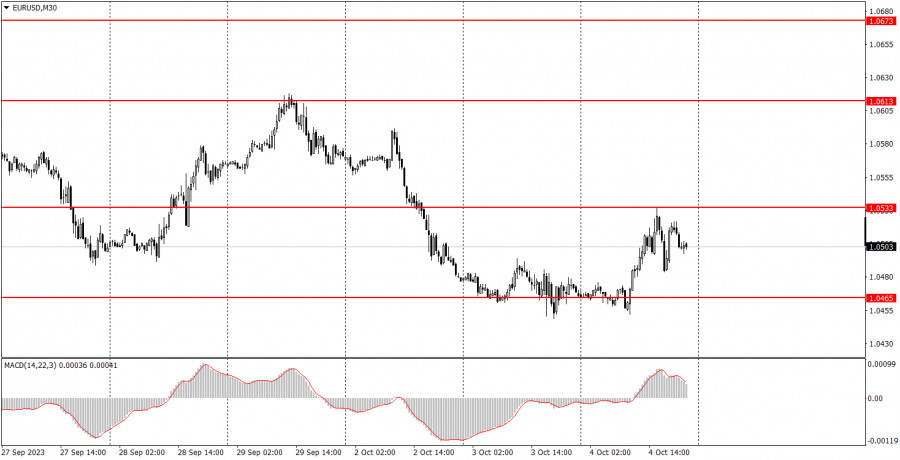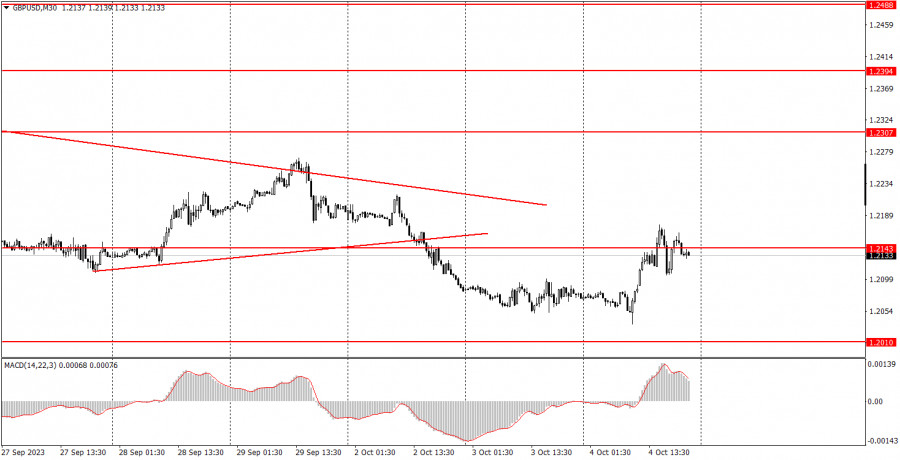Analysis of macroeconomic reports:

There are few macroeconomic events on Thursday, and it will be challenging to find anything even moderately significant among them. The UK Construction PMI and the weekly report on US unemployment claims will be released. One out of every 10 such reports deviates significantly from the forecast, but such occurrences are rare. Therefore, we do not expect any significant market reaction to either event. However, there is always a possibility of deviation in any report. This means that we cannot be certain that the market will not react. Nevertheless, there is still a high probability of observing a flat market or very weak movements on Thursday.
Analysis of fundamental events:
From Thursday's fundamental events, we can highlight the speeches of officials of the European Central Bank and the Federal Reserve. In the European Union, Luis de Guindos and Philip Lane will speak, while in the US, Loretta Mester, Thomas Barkin, and Mary Daly will take the stage. Take note that these events can set the tone for the market, based on which medium-term decisions may be made. In simpler terms, the stronger the hawkish rhetoric from Fed officials are and the weaker they are from ECB officials, the higher the chances that the euro will fall further.
General conclusion:
There are no significant events on Thursday. Theoretically, any event on the calendar can provoke a market reaction or simply surprise with an unexpected value or meaning, but it will be difficult to expect such developments on Thursday. Most likely, both currency pairs will trade with low volatility and attempt to form new phases of the bullish correction.
Basic rules of a trading system:
1) Signal strength is determined by the time taken for its formation (either a bounce or level breach). A shorter formation time indicates a stronger signal.
2) If two or more trades around a certain level are initiated based on false signals, subsequent signals from that level should be disregarded.
3) In a flat market, any currency pair can produce multiple false signals or none at all. In any case, the flat trend is not the best condition for trading.
4) Trading activities are confined between the onset of the European session and mid-way through the U.S. session, post which all open trades should be manually closed.
5) On the 30-minute timeframe, trades based on MACD signals are only advisable amidst substantial volatility and an established trend, confirmed either by a trend line or trend channel.
6) If two levels lie closely together (ranging from 5 to 15 pips apart), they should be considered as a support or resistance zone.
How to read charts:
Support and Resistance price levels can serve as targets when buying or selling. You can place Take Profit levels near them.
Red lines represent channels or trend lines, depicting the current market trend and indicating the preferable trading direction.
The MACD(14,22,3) indicator, encompassing both the histogram and signal line, acts as an auxiliary tool and can also be used as a signal source.
Significant speeches and reports (always noted in the news calendar) can profoundly influence the price dynamics. Hence, trading during their release calls for heightened caution. It may be reasonable to exit the market to prevent abrupt price reversals against the prevailing trend.
Beginning traders should always remember that not every trade will yield profit. Establishing a clear strategy coupled with sound money management is the cornerstone of sustained trading success.
The material has been provided by InstaForex Company - www.instaforex.comfrom Forex analysis review https://ift.tt/JQ3jqgT
via IFTTT

